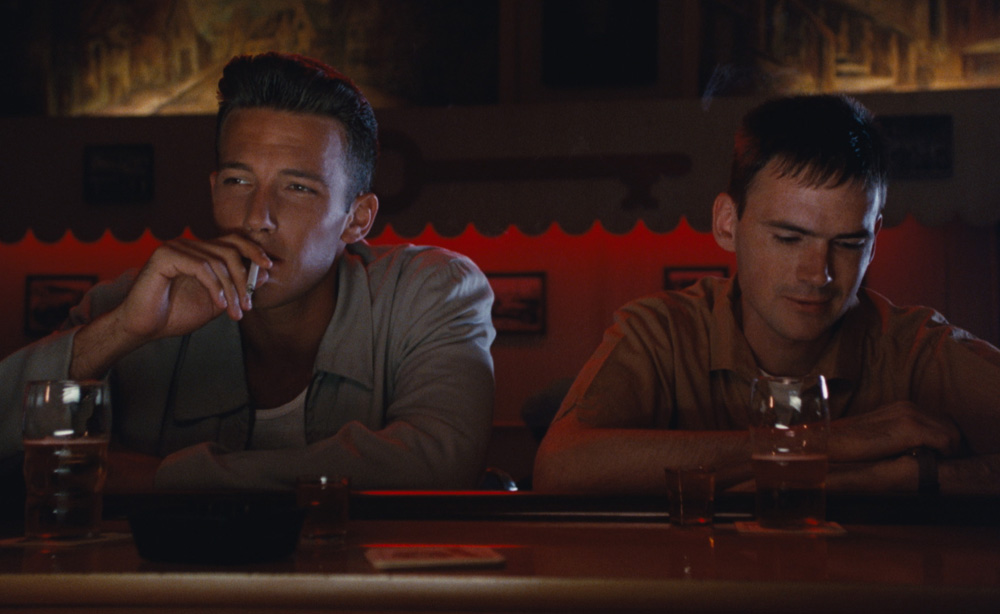As recently as two years ago, it would’ve come as a shock for Nick Offerman to be sitting on stage in Los Angeles at the Laemmle Royal for a Q & A for “Going All the Way,” but twenty-five years ago, it would’ve seemed even more improbable. Working primarily in Chicago’s theater scene, the future “Parks and Rec” star had a bit part in “Chain Reaction” that was left on the cutting room floor when he learned of a shoot going on just east in Indiana. He would be one unknown actor of many in the adaptation of Dan Wakefield’s 1950s-set novel, playing the part of Wilks, an obnoxious townie that makes the surreal experience of coming home for a pair of soldiers returning from the Korean War just a bit more discomfiting. Still, he was the one out of his element as he made his way to the set, tagging along with Jeff Buelterman, a fellow actor from the Windy City, where the basic accoutrements of a modest indie production made him feel as if he were stepping into an extravagant blockbuster.
“We drove down together from Chicago and [Jeff] had done a couple of other jobs, so he had taught me about per diem, and he’s like, ‘This is the deal. We stayed at a nice hotel and he’s like, they give you money every day for food and you save it and then get a filet mignon’ — he literally taught me what filet mignon was. It’s an incredible steak,” Offerman laughed. “And these guys [on the production] were so generous to me, they were just very encouraging and you were one of the main reasons I moved to Los Angeles, just because [they] literally said, “You make really funny faces. You should come to Hollywood.
“When I got here and nobody else agreed with them for many years, they bought me sandwiches and took care of me and I’m very grateful,” Offerman added, acknowledging it might seem a bit unusual for someone with less than five minutes of screen time to join director Mark Pellington, editor Leo Trombetta and producer Tom Gorai on stage. “That’s why I came out because you guys really took good care of me and I’m so glad we got to do this tonight because there’s a lot of wizardry going on up on that screen.”
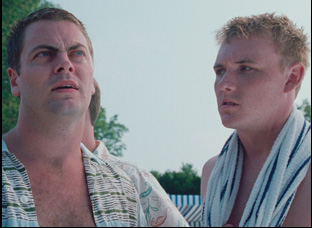
“It got decent reviews at Sundance and no Hollywood studio is ever going to say make it longer and darker and slower, right? They’re going to say make it shorter and funnier,” said Pellington, who was pleased to discover that the rough cut was more in line with the ruminative spirit of Wakefield’s novel about pent-up emotions than the sex comedy involving pent-up hormones he ended up delivering. “Cut to I’m doing a deal with with Village Roadshow for ‘Mothman’ and ‘Arlington Road’ [two other films Pellington directed for “Going All the Way”’s producer Lakeshore] and I tell them, ‘Hey guys, you have a movie that never saw the light of day. It never went to TV, it never went to cable, never went to streaming. It didn’t really have an ancillary life, so it was kind of dead, but you’ve got a Ben Affleck movie that nobody’s seen.”
Time may not have been kind to “Going All the Way” as far as distribution was concerned, but it certainly has been in terms of the talent involved. Not only was the film an early showcase for the likes of Offerman, Ben Affleck, Jeremy Davies, Rachel Weisz, Rose McGowan and Amy Locane, but it was completely stacked behind the scenes with a crew that included production designer Therese dePrez, a veteran of Gregg Araki productions who would go on to work on “Black Swan” and “Stoker” before her untimely death in 2017, and costume designer Arianne Phillips, who would become a trusted collaborator of Tom Ford and Madonna, to make its period detail sing. Although the world had not known yet what an ensemble this was, Pellington knew what he had on his hands, filming everything that was in Wakefield’s 135-page screen adaptation of his own book, even though it was to be expected that the director would have to shave things down to something under two hours.
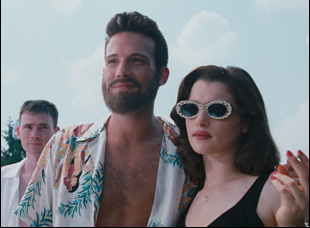
For his part, Wakefield is said to have enjoyed the original theatrical version of “Going All the Way,” which he originally wrote at the behest of friends Joan Didion and John Gregory Dunne, with Pellington recalling how the famed literary couple insisted that he stay at their house and not leave until he finished up a first draft of the novel based on his own early life in small town Indiana amidst the cultural conformity of the Eisenhower era. However, with his mind set on reworking the film, Pellington sought to include even more of his voice, believing a new cut could be tied together with narration that would come directly from Wakefield’s novel. Incidentally, he had been attracted all the way back in the ‘90s to working with Trombetta as an editor because of his ability to work with sound — though it would come out nearly a decade after “Going All the Way,” Pellington was inspired by the “detached third person quality” of his work with omniscient narration on Todd Field’s “Little Children” for the new version – and after going back to the book and plucking out specific passages, he and Trombetta set about completely reworking the film with the editor’s cut as a guide.
“All of that was recorded on my iPhone amazingly,” Trombetta said of the narration. “I’m stunned at how clear and nice it is because it was just me in my house doing three or four versions of each line and putting it together.”

The premise may have lent itself to a “Porky’s”-style sex farce when proof of the men’s masculinity would happen in the bedroom, but lost in such a treatment was the fact that women were used along the way — from Buddy (Locane), a young woman Sonny strings along when he can’t bring himself to tell her he doesn’t share her affections, to Sonny and Gunner’s mothers (Jill Clayburgh and Lesley Ann Warren) who clearly comport themselves to cater to the needs of the men in their lives. (Watching McGowan now as Gale Ann, who is seen as no more than a would-be one-night-stand for Sonny, is bone-chilling stuff, given how she was used and abused in the industry.) When there was inherent misogyny in what was thought to be commercial at the time, the version that resulted in some ways became an amplification of what it sought to critique, with the ways in which toxic masculinity warps perspective becoming the first thing to go when cuts needed to be made for a reasonable run time.
“It was three hours long, so we thought if we take out the entire section with Ben Affleck has the beard [that would get it down], then it started to be death of a thousand cuts,” said Trombetta, referring to a large chunk of the movie in which Gunner rebels by growing facial hair, leading to ridiculous accusations that he’s embraced communism. “The one that really killed me was the scene of Jill Clayburgh looking at her younger self.”
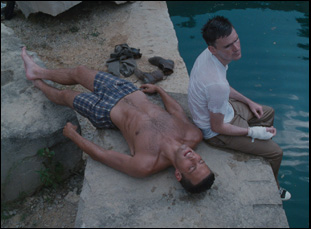
Although Pellington’s distinctive impressionistic style no doubt led to him directing “Going All the Way” in the first place, coming off the triumph of directing the iconic video for Pearl Jam’s “Jeremy,” it was largely absent from the original cut even if he did actually act on his instincts for optical trickery while shooting the film. He was less inclined to experiment after plans to collaborate with “I Shot Andy Warhol” cinematographer Ellen Kuras fell apart less than two weeks before shooting, turning to future “Till” director of photography Bobby Bukowski on short notice, but nonetheless amassed the odds and ends throughout filming that would evoke the feeling of being caught an emotional tailspin, a signature that the director would apply to later films such as “Henry Poole is Here” and “Nostalgia” and is now evident as early as its sensational new opening title sequence.
“It wasn’t this retro nostalgia journey [as the original version was], so all these optical things and objects we had shot for these weird sequences, I just transferred it all – film strips, optical loops — and I said to Sergio [Pinheiro], “Chop it up, man. Do your version of ‘Se7en’ and we had Pete Adams do the score that was atonal and weird” said Pellington, who noted the unique creative puzzle of having the rights to a number of songs originally licensed for the film, but rearranging them for maximum effect and commissioning new music to compliment the original score by Tomandandy.
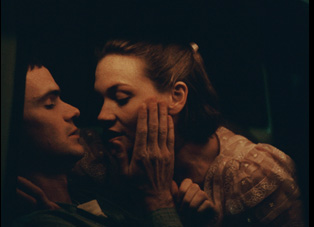
“Thank [O-Scope’s president] Dan Berger for making it happen because if it wasn’t for him, were like, ‘This is a new movie.’ They didn’t think of it as some old movie. They just looked at it as [something] they dug and that spoke to them now, which I really respected and appreciated because it wouldn’t have seen the light of day [without them].”
Following the weeklong run in Los Angeles, the “Going All the Way: Director’s Edit” is set to play at theaters across the country, beginning this week with an engagement at the Quad Cinema in New York where Pellington will be joined for Q & As by Alex Ross Perry and New York film critic Bilge Ebiri, a development that the director struggled to comprehend when it had been collecting dust for so long.
“This is like some karmic thing [where] there is a chance to get to show your earlier work in a way that is a little more complete,” said Pellington. “And Dan Wakefield is now 90 years old and he now has glaucoma, but he got to [experience] this version eight months ago and the greatest gift for me is [showing] this guy who wrote this story that I read when I was 14 years old in 1976, and cut to 2022 and it’s coming out in the world and people are responding to it in a really nice way.”
Added Offerman, “It’s truly miraculous,” said Offerman. “To have it languish in a box in Valencia figuratively and literally, I’m just so grateful because this happens to so much gorgeous art, [where there’s] so much passion and it’s just sitting in a box on somebody’s shelf because of the time, because of the way things go, because of the fashion. There’s so many works of art that each frame you could hang on your wall and be incredibly proud.”
“Going All the Way” opens on December 16th in New York at the Quad Cinema, December 23rd at the Bow Tie, Criterion Cinema in New Haven, CT and January 23rd in Columbus, OH at the Gateway Cinema.




